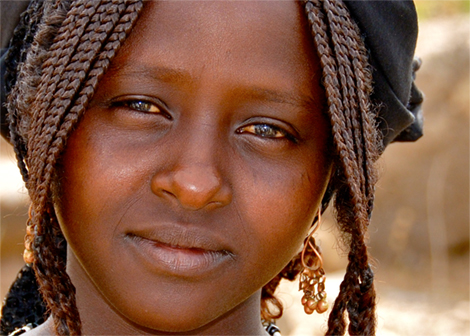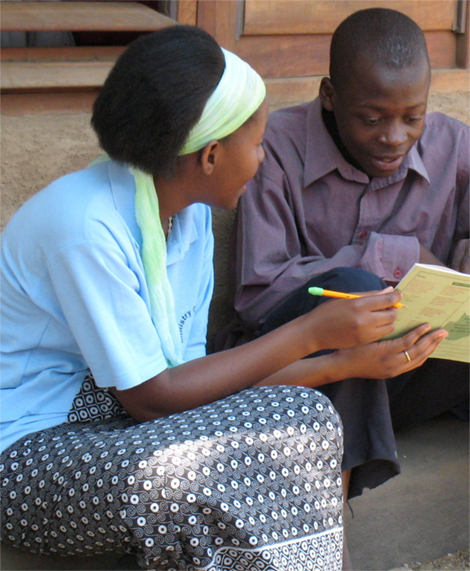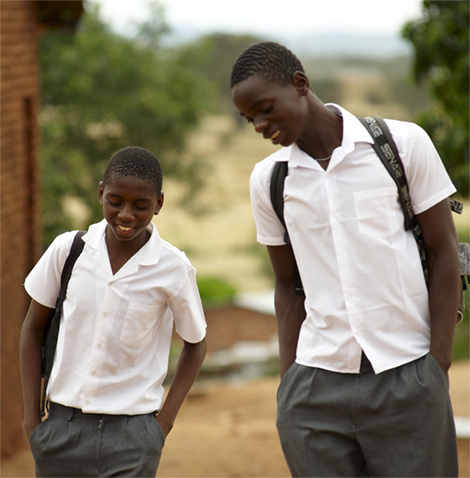Churches and faith-based organizations (FBOs) are grounded in service to others and follow the teachings of Jesus by showing love for all those around us. We understand that it is vital both to share expressions of love and faith and also to ensure that our actions are consistent with our words. As stated in 1 John 3:18: "Let us not love with words or tongues but with actions and in truth." As Christians, one way we "love with actions" is by protecting the vulnerable, and many religious organizations work to save the lives of those who are most susceptible to suffering.

Ethiopia-Danakil- Afar girl, 2011, photo by Donatella Venturi
One serious cause of suffering is unsafe pregnancies and births—a leading cause of death for women and girls in many parts of the world. For this and other reasons, family planning and maternal and child health are inexorably linked. Christian Connections for International Health defines family planning as "enabling couples to determine the desired number and timing of pregnancies, including the voluntary use of methods for preventing pregnancy-not including abortion- that are harmonious with their values and religious beliefs."1 The National Association of Evangelicals states that "raising children is a joy and a blessing, and it is also a long-term responsibility. Pregnancy planning may help a couple to care for their marriage and family by timing and spacing pregnancies."
Faith-based organizations provide over 40 percent of health care services in some developing countries and have been expanding access to effective family planning methods to hard-to-reach communities for more than 30 years.3,4 Churches and Christian FBOs offer health services for people at every stage of their lives, including youth. Although implementing family planning programs, services, and support for young people can be complicated and controversial, there are many reasons to engage in this important, lifesaving work. Young people deserve a chance to survive and thrive.
The decision to consider family planning should not be taken lightly. Through prayer and personal reflection, a couple must consider whether they will be able to support, nurture, and educate any children they have.
Family planning reduces abortions by decreasing the number of unintended, poorly timed, and high-risk pregnancies.2
The HIV Connection
Around the world, 5 million people ages 15–24 are living with HIV.5 Since many FBOs are already engaging in HIV prevention programs and services, these provide an entry point for family planning education and services for youth. Because the pathway to becoming HIV-infected and pregnant is often the same—through unprotected sex—HIV prevention programs and services provide a useful entry point for youth who want to prevent and time pregnancy to the healthiest period.
Early Marriage, Pregnancy, and Childbearing
In the developing world, one in nine girls is married by age 15, one in three before age 18. Every year, more than 7 million girls under the age of 18 (including 2 million girls younger than 15), give birth in developing nations. Those who survive childbearing face poverty, limited opportunities for education and employment, and potentially lifelong health challenges.7,8 Young women and couples with access to family planning are more likely to be able to feed, clothe, and educate their children. Healthy timing and spacing of pregnancies enables young women to attend school and find jobs to improve their economic security. Reducing early marriage and pregnancy is important to improving the health and economic outcomes of young mothers and their babies.

Children at First Lubuto Library. 2007, Lubuto Library Partners
Additionally, although many Christians do not condone unmarried sexual activity, we must recognize its existence. Young people are engaging in sex both within and outside of marriage, and FBOs can be integral in providing lifesaving family planning services, regardless of the marital status of youth.
Risks Associated With Early Unplanned Pregnancy
RISKS TO THE MOTHER: Pregnancy and complications from childbirth are the leading causes of death for adolescent girls (ages 15–19) in the developing world. Girls 15 and under are five times more likely to die in childbirth or experience serious complications than those 16 and older.
An adolescent girl whose body has not developed enough for safe childbirth is at higher risk of physical complications compared to her counterparts age 20-35. One example is that younger mothers are at high risk of having a condition called fistula. A baby can become trapped in the narrow pelvis of a young girl during prolonged labor, which results in dead tissue and the development of a hole in the birth canal. When this condition is untreated, obstetric fistula can cause infection and incontinence, which can lead to stigmatization and abandonment by the girl's husband and family. There are more than 2 million young women living with the condition untreated in Asia and sub-Saharan Africa.9
HEALTHY TIMING AND SPACING OF PREGNANCY
- Women should delay their first pregnancy until at least age 18.
- After a live birth, women should wait at least 24 months before attempting another pregnancy in order to reduce the risk of adverse maternal, perinatal, and infant outcomes.
- After a miscarriage or induced abortion, women should wait at least 6 months before attempting another pregnancy to reduce risks of adverse maternal and perinatal outcomes.11,12
RISKS TO NEWBORNS: Young mothers are not the only ones at risk. Babies born to teenage mothers are more likely to be born premature and with a low birth weight and are 50 percent more likely to die in their first month of life than those born to women in their 20s.10
What Faith Communities Can Do to Engage Youth in Sexual and Reproductive Health
To be most effective in mobilizing your church or FBO to work with youth on issues related to the healthy timing and spacing of pregnancy, it is important to identify others within your organization who can be "champions" of this effort. Other strategies include:
In community groups, during fellowship, or in religious services:
- Emphasize the importance of keeping young people, especially girls, in school.
- Make sure parents and grandparents understand the need to educate youth on sexuality by having open and honest discussions addressing any concerns.
- Engage faith leaders to oppose forced and early marriage and begin community discussions discouraging the practice.
- Encourage family planning couples counseling to promote male engagement in fertility decision making and to support delaying and spacing pregnancies if the wife is under the age of 18.
- Engage faith and community leaders to actively promote gender equality and to oppose gender-based violence, including sexual violence.
- Provide messages on healthy timing and spacing of pregnancy.
For women's and men's groups and in pastoral or individual counseling:

Increase in education=decrease in child marriage. 2014, Jessica Lea/Department for International Development
- Integrate messages about healthy timing and spacing of pregnancy into educational programs and support services, including couples' counseling and education on
reproductive health, maternal health, family planning, and HIV prevention. - Engage extended family members in education programming. This is especially important for young married women who may have limited knowledge of puberty, the menstrual cycle, and fertility.
- Discuss with young people the idea of delaying sexual activity. When appropriate, provide counseling on family planning methods to ensure that young people and their families are able to make informed decisions.
- Discuss gender-based violence, including sexual violence, with both men and women. Provide appropriate referrals for youth-friendly health services and support.
For youth groups or other groups where married youth may be involved:
FACT
Ninety percent of adolescent pregnancies in the developing world are to girls who are already married.6
- While being respectful of the local context give information about sexuality and fertility, the benefits of delaying sexual initiation and first pregnancy, birth spacing, and gender inequities.
- Support mentoring programs that help engage youth, in healthy decision-making, life skills, and leadership.
- Use technology—such as text messages, social media, radio, and other media—to communicate with youth.
- Counsel couples to encourage delaying the first pregnancy until at least age 18.
- Identify and provide referrals to youth-friendly services that recognize the unique family planning needs of young people.
- Discuss gender-based violence, including sexual violence, with both boys and girls. Provide appropriate referrals for youth-friendly health services and support.
On a larger scale, Christian FBOs might also consider advocacy efforts to influence national policy and government spending related to family planning issues.
Examples of Engaging Young People in Christian Faith-Based Family Planning Programs

A long way from home, 2009, Dylan Thomas / UKaid / Department for International Development
World Vision works to ensure that girls in India are not married before age 18. In May 2014, World Vision India organized a Global Week of Action that brought together religious leaders from all backgrounds to advocate for the healthy timing and spacing of pregnancies. They wrote a recommendation to the Government of India that all religious leaders be required to check birth certificates when they are asked to perform marriages to see whether the girls are at least 18 years old.
The Institute for Reproductive Health (IRH) at Georgetown University provides young people with access to information about the physical, emotional, and social changes that happen during puberty. By doing so, IRH helps young people make healthier decisions later in life about sexual activity and reproduction. For example, IRH's GREAT Project uses radio episodes, games, and training to engage young people about genderequitable attitudes and sexual and reproductive health. The organization also produced several toolkits to educate young people; these are implemented in local communities with faith-based and other community organizations. Some examples include:
- My Changing Body: "teach[es] girls and boys ages 10 to 14 years about the changes they experience as they approach puberty, and share[s] information in objective and reassuring terms"13
- CycleSmart Kit: "includes CycleBeads and a simple, factual brochure about puberty. The Kit also helps parents, teachers, health providers, peer-educators and others talk to young girls and boys about their changing bodies and how to stay healthy and safe."14
- Grow Up Smart: an interactive curriculum that "aims to increase body literacy, fertility-awareness, puberty knowledge, gender-equitable attitudes, menstruation management skills (for girls), interpersonal communication skills, and self-care behaviors among very young adolescent girls and boys."15
References
1 Christian Connections for International Health (2014). Why Christian Values Support Family Planning [Infographic].
2 Secura GM, Madden T, McNicholas C, Mullersman J, Buckel CM., Zhao Q, and Peiper JF. Provision of No-Cost, Long-Acting Contraception and Teenage Pregnancy N Engl J Med 2014; 371:1316-1323 October 2, 2014DOI: 10.1056/NEJMoa1400506
3 Kagawa RC, Anglemyer A, Montagu D (2012) The Scale of Faith Based Organization Participation in Health Service Delivery in Developing Countries: Systemic Review and Meta-Analysis. PLoS ONE 7(11): 10.1371/annotation/1e80554b-4f8a-4381-97f1-46bf72cd07c9. doi:10.1371/annotation/1e80554b-4f8a-4381-97f1-46bf72cd07c9
4 Bandy G, Crouch A, et al, 2008. Building From Common Foundations: the World Health Organization and faith-based organizations. Eds. Karpf T and Ross A. World Health Organization.
5 UNAIDS. Opportunity in Crisis. UNAIDS, June 2011.
6 WHO. Fact sheet on adolescent health. WPRO | WHO Western Pacific Region; 2011 [cited 2014 Nov 20].
7 UNFPA. Motherhood in Childhood: Facing the challenge of adolescent pregnancy. New York, New York; 2013.
8 UNICEF. The State of the World's Children 2013: Children with Disabilities. New York, New York; 2013.
9 WHO. 10 facts on obstetric fistula. World Health Organization; 2014 [cited 2014 Nov 20].
10 UK Save the Children. Every Woman's Right: How family planning saves children's lives. The Save the Children Fund. London, UK; 2012.
11 Report of a WHO Technical Consultation on Birth Spacing. World Health Organization, 2006.
12 The Health Communication Capacity Collaborative HC3. (2014) Engaging Families for Healthy Pregnancies - A Focused Desk Review of Knowledge, Attitudes and Behaviors Related to Pregnancies in Three High-Risk Situations: Advanced Maternal Age; High Parity; and Rapid Repeat Pregnancies After Abortion or Miscarriage. Baltimore: Johns Hopkins Bloomberg School of Public Health Center for Communication Programs.
13 IRH. My Changing Body: Body Literacy & Fertility Awareness for Young People (2nd Edition). Institute for Reproductive Health; 2011 [cited 2015 May 13].
14 IRH. How to Use the CycleSmart™ Kit with Young People: Programmatic Guidelines. Institute for Reproductive Health; 2013 [cited 2015 May 13].
15 IRH. A3 Project Expanding Family Planning Access, Availability, and Awareness. Institute for Reproductive Health; 2015 [cited 2015 May 13].
